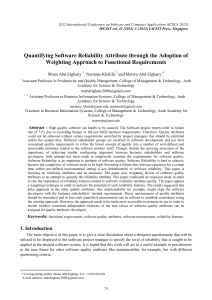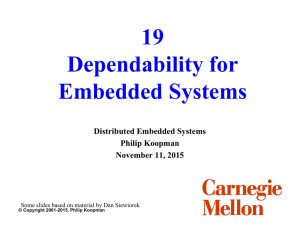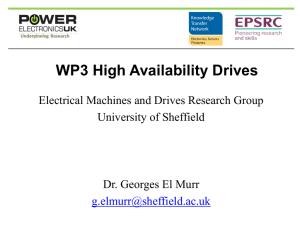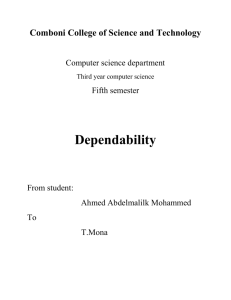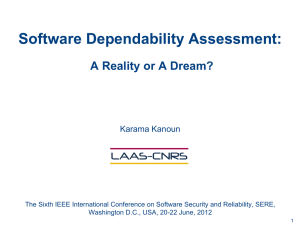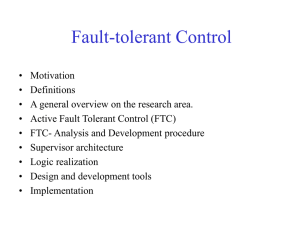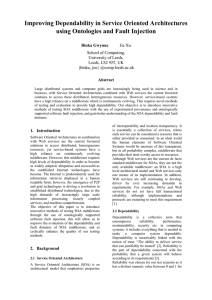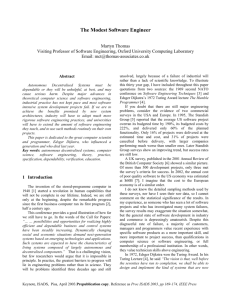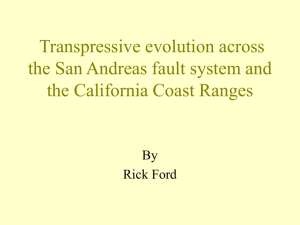Introduction to Dependability
advertisement
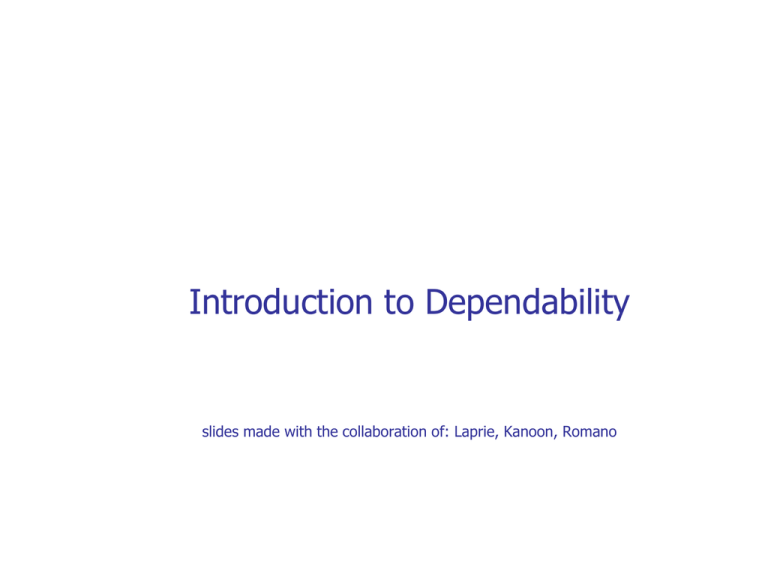
Introduction to Dependability slides made with the collaboration of: Laprie, Kanoon, Romano Overview Dependability: "[..] the trustworthiness of a computing system which allows reliance to be justifiably placed on the service it delivers [..]" IFIP 10.4 Working Group on Dependable Computing and Fault Tolerance Introduction Dependability attributes Application with dependability requirements Impairments Techniques to improve dependability Fault tolerant techniques Introduction Dependability attributes Reliability R(t): continuity of correct service Availability: readiness for correct service A(t) (transient value), A /steady state value) Safety S(t): absence of catastrophic consequences on the user(s) and the environment Performability P(L,t): ability to perform a given performance level Maintainability: ability for a system to undergo modifications and repairs Testability: attitude of a given system to be tested Security: degree of protection against danger, damage, loss, and criminal activity. Reliability R(t), Availability A(t) & A Reliability, R(t): the conditional probability that a system performs correctly throughtou the interval (t0,t), given that the system was performing correctly at time t0. Istantaneous Availability, A(t): the probability that a system is operating corretly and is available to perform its functions at the instant of time t Limiting or steady state Availability, A: the probability that a system is operating correctly and is available to perform its functions. Reliability versus Availability Availability differ from reliability in that reliability involves an interval of time, while availability at an istant of time. A system can be highly available yet experience frequent periods of inoperability. The availability of a system depends not only on how frequently it becomes inoperable but also how quickly it can be repaired. Safety S(t) Safety, S(t): the probability that a system will either perform its functions correctly or will discontinue its fucntions in a manner that does not disrupt the operation of other systems or compromise the safety of any people associated directly or inderectly with the syste. The Safety is a measure of the fail-safe capability of a system, i.e, if the system does not operate correctly, it fails in a safe manner. Safety and availability differ because availability is the probability that a system will perform its function corretly, while Safety is the probability that a system will either perform its functions corrctly or will discontinue the functions in a manner that causes no harm. Performability P(L,t) Performability, P(L.t): the probability that a system performance will be at, or above, some level L, at instant t (Fortes 1984). It is a measure of the system ability to achieve a given performance level, despite the occurrence of failures. Performability differs from reliability in that reliability is a measure of the likehooh that all of the functions are performed correctly, while performability is a measure of likehood that some subset of the functins is performed correctly. Security Security is the degree of protection against danger, damage, loss, and criminal activity. Security as a form of protection are structures and processes that provide or improve security as a condition. The key difference between security and reliability-availabilitysafety is that security must take into account the actions of people attempting to cause destruction. Maintainability Maintainability is the probability M(t) that a malfunctioning system can be restored to a correct state within time t. It is a measure of the speed of repairing a system after the occurrence of a failure. It is closely correlated with availability: - The shortest the interval to restore a correct behavior, the highest the likelihood that the system is correct at any time t. - As an extreme, if M(0) = 1.0, the system will always be available. Testability Testability is simply a measure of how easy it is for an operator to verify the attributes of a system. It is clearly related to maintainability: the easiest it is to test a malfunctioning system, the fastest will be to identify a faulty component, the shortest will be the time to repair the system. Applications with dependability requirements from Pradhan’s book Long life applications Critical-computation applications Hardly maintainable applications (Maintenance postponement applications) High availability applications Long life applications: applications whose operational life is of the order of some year. The most common examples are the unmanned space flights and satellites. Typical requirements are to have a 0.95 or greater probability of being operational at the end of ten year period. This kind of system should or not have maintenance capability Applications with dependability requirements (2/3) Critical-computation applications: applications that should cause safety problem to the people and to the business. Examples: aircraft, airtrafic flight control system, military systems, infrastructures for the control of industrial plants like nuclear or chemical plants. Typical requirements are to have a 0.999999 or greater probability of being operational at the end of three hour period. In this period normally it is not possible a human maintenance. Hardly Maintainable Applications : applications in which the maintenance is costly or difficult to perform. Examples: remote processing systems in not human region (like antartide continent). The maintenance can be scheduled independently by the presence of failure Applications with dependability requirements (3/3) High availability applications: applications in which the availability is the key parameter. Users expect that the service is operational with high probability whenever it is requested. Examples: banking computing infrastructures. The maintenance can be done immediately and “easily”. Number of Nines as an Availability Metric Availability % Downtime per year Downtime per month* Downtime per week 90% 36.5 days 72 hours 16.8 hours 95% 18.25 days 36 hours 8.4 hours 98% 7.30 days 14.4 hours 3.36 hours 99% 3.65 days 7.20 hours 1.68 hours 99.5% 1.83 days 3.60 hours 50.4 min 99.8% 17.52 hours 86.23 min 20.16 min 99.9% ("three nines") 8.76 hours 43.2 min 10.1 min 99.95% 4.38 hours 21.56 min 5.04 min 99.99% ("four nines") 52.6 min 4.32 min 1.01 min 99.999% ("five nines") 5.26 min 25.9 s 6.05 s 99.9999% ("six nines") 31.5 s 2.59 s 0.605 s Impairments to dependability IMPAIRMENTS TO DEPENDABILITY delivered service deviates from fulfilling the system function FAILURE part of system state liable to lead to failure ERROR adjudged or hypothesized cause of error(s) FAULT 16 Causes and effects 17 Example of human causes at design phase 18 Example of physical cause (permanent) 19 Example of human cause at operational phase OPERATOR ERROR IMPROPER HUMAN-MACHINE INTERACTION FAULT ERROR PROPAGATION WHEN DELIVERED SERVICE DEVIATES (VALUE, DELIVERY INSTANT) FROM FUNCTION FULFILLING FAILURE 20 Example of physical cause (transient) ELECTROMAGNETIC PERTURBATION FAULT FAULT IMPAIRED MEMORY DATA ACTIVATION FAULTY COMPONENT AND INPUTS ERROR PROPAGATION WHEN DELIVERED SERVICE DEVIATES (VALUE, DELIVERY INSTANT) FROM FUNCTION FULFILLING FAILURE 21 Failure modes: taxonomy FAILURE MODES FAILURES PERCEPTION BY SEVERAL USERS DOMAIN CONSEQUENCES ON ENVIRONMENT … VALUE FAILURES TIMING FAILURES CONSISTENT FAILURES STOPPING (HALTING) FAILURES INCONSISTENT (BYZANTINE) FAILURES BENIGN FAILURES CATASTROPHIC FAILURES FAIL-SAFE SYSTEM OUTPUT VALUE FROZEN FAILPASSIVE SYSTEM SILENCE (ABSENCE OF EVENT) FAIL-HALT ("FAIL-STOP") SYSTEM FAILSILENT SYSTEM 22 Fault classification 23 Fault classification (1/2) Fault classification (2/2) 25 Human-made faults 26 Human-made faults: statistics Human-made interaction faults result from operators errors errors: negative side of human activities positive side: adaptability aptitude to address unforecasted situations Growing relative importance Causes of accidents in commercial flights in the USA Accidents per million take-offs 1970-78 1979-86 Technical defects 1,49 (45%) 0,43 (33%) Weather conditions 0,82 (25%) 0,33 (26%) Human errors 1,03 (30%) 0,53 (41%) Total 3,34 1,29 Consciousness that most interaction faults have their source in the system design Fault natures: some statistics (1/3) Traditional systems, non fault-tolerant USA, 450 companies, 1993 (FIND/SVP) MTBF : 6 weeks Average downtime after failure: 3.5 h Hardware Processors 24% Disks 27% Software Communication processors Communication network Procedures 51% 22% 11% 10% 6% Japan, 1383 organizations, 1986 MTBF : 10 weeks Average downtime after failure: 1.5 h Vendor hardware and softw are, maintenance Application software Communication network Environment Operations 42% 25% 12% 11% 10% 5 months 9 months 18 months 24 months 24 months Fault natures: some statistics (2/3) 29 Fault natures: some statistics (3/3) MTBF: Mean Time Between Fault In the table MTBE and MTFF denotes MTBF for all kind of faults and for permanent ones, respectively System,Technology PDP-10, ECL CM* LSI-11, NMOS C.vmp TMR LSI-11, NMOS Telettra, TTL SUN-2, TTL-MOS 1 Mx37 RAM, MOS MTBE for MTFF for all fault classes permanent faults (h) (h) 44 128 97 - 328 80 - 170 689 106 MTBE/MTFF 800-1600 4200 4900 1300 6552 1450 13 stations of CMU Andrew network, 21 stations.years Number manifestations Mean time to manifestation (h) Permanent faults Intermitent faults Transient faults 29 610 446 6552 58 354 System crashes 298 689 0,03 - 0,06 0,03 0,02 - 0,07 0,06 - 0,13 0,11 0,07
